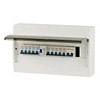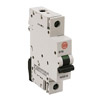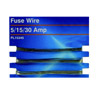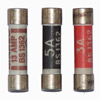Fuses Within Domestic Electrical Circuits
Introduction

As electricity passes through wires and appliances, it causes the components of the circuit to heat up, and if unchecked, this heat can overload the circuit causing damage and potentially a fire.
To prevent this from happening, ‘weak links’ are deliberately placed in the circuit which break the flow of current before any real damage is done. These ‘weak links’ are fuses which consist of a thin strand of wire which is designed to melt and break when the current flowing through them exceeds a specified rating.
- Fuses work at a specific flow of current, or amperage, so they are rated in amps (A).
Most appliances are marked with their wattage and voltage, so you can calculate the amperage of the fuse you should add to the circuit as follows:
- Watts ÷ Volts = Amps
Choose a fuse that is the nearest size above the calculated required amperage.
- Never add a fuse of too high a rating to a circuit. This would effectively remove any protection it offers as it will fail to trip at the correct current and could therefore allow a potentially hazardous fault to go undetected.
Types of fuses used in domestic electrics

The main fuse is installed on the incoming electricity supply by the Electricity Board and can only be accessed by them. It rarely blows as it has a high rating, but is there to prevent damage caused by any surges in supply, and to protect the electricity supplies to your neighbours in the even of a fault in your home.
Fuses in the consumer unit or fuse box protect each of the various circuits around your home. The exact nature of the fuses will depend on how modern your consumer unit is, and nowadays it is difficult to find replacement parts for anything other than the most modern consumer units that use MCBs instead of fuses.
Whatever era your consumer unit is from, you should use fuses for each circuit as follows:
- Use a 5amp fuse or 6amp MCB for lighting circuits
- Use a 15amp fuse or 16amp MCB for immersion and storage heater circuits
- Use a 20amp fuse or MCB for small radial circuits up to 20m²
- Use a 30amp fuse or 32amp MCB for larger radial circuits, ring circuits up to 100m², cookers and electric showers up to 7200W
- Use a 45amp fuse or 50amp MCB for circuits serving cookers and electric showers up to 10800W
Note that electric cookers and showers should each have a dedicated circuit.
- Before replacing any fuse or resetting any MCBs, you should investigate the cause of the circuit failure. Usually, whichever appliance you switched on immediately prior to the cut out, or has most recently been added to the circuit, has caused overload or has a fault.
Miniature circuit breakers (MCBs)

Unlike traditional fuses, MCBs do not break a circuit by allowing a thin wire to melt, but instead have a switch that ‘trips’, or automatically flicks off, when the current passing through them and their circuit is too great.
It is easy to see if a MCB has tripped, as its switch will be in the ‘off’ position. It’s also quick and easy to reactivate the circuit by flicking the switch back on again.
- When purchasing new or replacement MCBs, make sure they are Type B class and manufactured to British Standard BSEN 60898.
Cartridge fuses

These look like larger versions of 13amp plug fuses, varying in size and colour according to their rating. These fuses fit into spring clips mounted on a carrier which is then slotted into the consumer unit.
Unfortunately, it is not easy to tell if these fuses have in fact blown. To do so:
- Turn all the power off on the consumer unit.
- Whichever appliance stopped working, remove the carrier for this circuit from the consumer unit. For example, if appliances plugged into sockets on a ring main stop working, check the fuse for this circuit.
- Replace the fuse by pressing a new one of the correct rating into the spring clips, and refit the carrier into the consumer unit.
- Turn the electricity back on and check that the appliance now works.
- Note that replacement fuses and carriers for this system are hard to source, and in this scenario, you are highly recommended to hire a professional registered electrician to install a modern consumer unit with MCBs.
Rewirable fuses

These fuses consist of a carrier that slots into the consumer unit and suspends a strand of fuse wire between two screwed terminals.
Although it is easy to visually check whether the fuse wire is intact, this system is old-fashioned as renewing the fuse wire can be a little time consuming. To do so:
- Turn all the power off at the consumer unit.
- Whichever appliance stopped working, remove the carrier for this circuit from the consumer unit. For example, if appliances plugged into sockets on a ring main stop working, check the fuse for this circuit.
- Replace the fuse wire by loosening the two terminals and removing the old broken wires.
- Wind a piece of new wire of the correct rating round one terminal and tighten the screw, then run the wire to the other terminal, leaving it slightly slack and attach in the same way.
- Cut off any excess wire and refit the carrier into the consumer unit.
- Turn the electricity back on and check that the appliance now works.
- Note that replacement fuses and carriers for this system are hard to source, and in this scenario, you are highly recommended to hire a professional registered electrician to install a modern consumer unit with MCBs.
Cartridge plug fuses

Found in UK rectangular pinned plugs, these fuses protect the circuit to the particular appliance they’re connected to, such that all other appliances using the same circuit can continue to function.
These fuses are available in 3amp, 5amp and 13amp ratings.
- Use a 3amp fuse in plugs attached to appliances up to 700 Watts
- Use a 5amp fuse in plugs attached to appliances from 700 to 1200 Watts
- Use a 13amp fuse in plugs attached to appliances from 1200 to 3000 Watts
Further information and useful links
- Find an Electrician near you
- Find a Electrical Merchants near you
- Find an Electrical Switches & Sockets supplier near you
- IEE Regulations
- Part P Competent Person Scheme
- National Inspection Council for Electrical Insulation Contracting
Site Pages
Featured Articles





